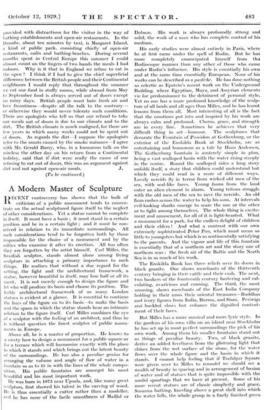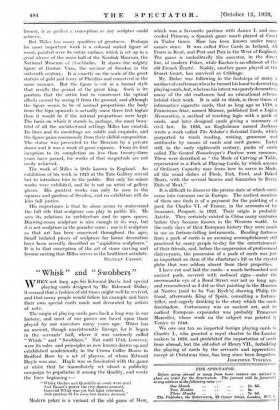A Modern Master of Sculpture R ECENT controversy has shown that
the bulk of criticism of a public monument tends to concen- trate on the actual sculptured figure itself to the neglect of other considerations. Yet a statue cannot be complete in itself. It must have a basis ; it must stand in a certain position and be in a certain light ; and it must be con- ceived in relation to its immediate surroundings. All such considerations tend to be forgotten both by those responsible for the choice of a monument and by the critics who examine it after its erection. All too often they are forgotten by the artist himself. Carl Milles, the Swedish sculptor, stands almost alone among living sculptors in attaching a primary importance to such things. He realizes that without a due regard for the setting, the light and the architectural framework, a statue, however beautiful in itself, may lose half or all its merit. It is not merely enough to design the figure and let who will produce its basis and choose its position. The feeble architectural framework of so many London statues is evident at a glance. It is essential to continue the lines of the figure on to its basis—to make the basis and the space in which the statue stands bear an intimate relation to the figure itself. Carl Miles combines the eye of a sculptor with the feeling of an architect, and thus he is without question the finest sculptor of public monu- ments in Europe.
Above all, he is a master of proportion. He knows to a nicety how to design a monument for a public square or for a terrace which will harmonize exactly with the place in which it stands and which brings out the latent beauty of the surroundings. He has also a peculiar genius for arranging the volume and angle of flow of water in a fountain so as to fit in with the lines of the whole compo- sition. His public fountains are amongst his most beautiful and his most important work.
He was born in 1875 near Upsala, and, like many great sculptors, first showed his talent in the carving of wood. He is thus essentially a cutter rather than a modeller, and he has none of the facile smoothness of Maillol or Dobson. His work is always profoundly strong and solid, the work of a man who has complete control of his medium.
His early studies were almost entirely in Paris, where he at first came under the spell of Rodin. But he has More completely emancipated himself from the Rodinesque manner than any other of those who came under Rodin's influence. His style is essentially his own and at the same time essentially European. None of his works can be described as a pastiche. He has done nothing so eclectic as Epstein's recent work on the Underground Building, where Egyptian, Maya, and Assyrian elements vie for predominance to the detriment of personal style. Yet no one has a more profound knowledge of the sculp- ture of all lands and all ages than Milles, and he has learnt lessons from them all. Most interesting of all is the fact that the emotions put into and inspired by his work are always calm and profound. Charm, grace, and strength are in every line. Sometimes he achieves that very difficult thing in art—humour. The sculptures that decorate the Fountain of Poseidon at Gothenburg, or the exterior of the Enskilda Bank at Stockholm, are as entertaining and humorous as a tale by Hans Andersen. The Gothenburg fountain is austerely simple in plan, being a vast scalloped basin with the water rising steeply in the centre. Round the scalloped sides a long story unfolds itself, a story that children could understand but which they could read in a score of different ways. Lovely nereids fly in terror from wicked old men of the sea, with seal-like faces. Young fauns from the land enter an alien element in alarm. Young tritons struggle with the old men of the sea to save the nereids. An old faun rushes across the water to help his sons. At intervals evil-looking sharks emerge to scare the one or the other or to fight among themselves. The whole thing is excite- ment and amusement, for all of it is light-hearted. What a monument for a park, for the endless delight of children and their elders ! And what a contrast with our own extremely sophisticated Peter Pan, which must mean so little to youngsters but which is so sentimentally satisfying to the parents. And the vigour and life of this fountain is essentially that of a northern art and the story one of northern seas : the fresh air of the Baltic and the North Sea is in so much of his work.
The Enskilda Bank has three reliefs over its doors in black granite. One shows merchants of the thirteenth century bringing in their cattle and their cash. The next, two bankers of the fourteenth century bartering and cal- culating, avaricious and cunning. The third, the most amusing, shows merchants of the East India Company holding in their arms their oriental treasures—Buddhas and ivory figures from India, Burma, and Siam. Periwigs and buckled shoes but enhance the dignified content- ment of their faces.
But Milles has a more musical and more lyric style. In the gardens of his own villa on an island near Stockholm he has set up in most perfect surroundings the pick of his own work. Among them his smaller fountains stand out as things of peculiar beauty. Two, of black granite, derive an added lovelineis from the glistening light that shines from the wet surface of the stone, for the water flows over the whole figure and the basin in which it stands. I cannot help feeling that if Trafalgar Square were given over to Milles to remodel we should see a wealth of beauty in spacing and in arrangement of basins of water and of statues that is quite impossible with the sordid spoutings that we have at present. Some of his more recent statues are of classic simplicity and grace. Susanna bathing, kneeling above a great shell into which the water falls, the whole group in a finely finished green bronze, is as perfect a conception as any sculptor could achieve.
But Miles has many qualities of greatness. Perhaps his most important work is a colossal seated figure of wood, painted over its entire surface, which is set up in a great alcove of the main hall of the Nordisk Museum, the National Museum of Stockholm. It shows the mighty figure of Gustav Vasa, the saviour of Sweden in the sixteenth century. It is exactly on the scale of the great statues of gold and ivory of Pheidias and conceived in the same manner. But the figure is cut in a formal style that recalls the period of the great king. Such is its position that the artist had to counteract the optical effects caused by seeing it from the ground, and although the figure seems to be of normal proportions the body from the hips upwards is actually some three feet higher than it would be if the natural proportions were kept. The basis on which it stands is, perhaps, the most beau- tiful of all the architectural settings Mules has created. Its lines and its mouldings are subtle and exquisite, and the figure gains enormously from their skilful composition. The statue was presented to the Museum by a private donor and it was a work of great expense. From its first inception to its completion no less than twenty-three years have passed, for works of that magnitude are not easily achieved.
The work of Mules is little known in England. An exhibition of his work in 1925 at the Tate Gallery served but to introduce him to the public. But only his minor works were exhibited, and he is not an artist of gallery pieces. His greatest works can only be seen in the squares and gardens of Sweden, and no exhibition will do him full justice.
His importance is that he alone seems to understand the full role that sculpture can play in public life. He sees its relations to architecture and to open spaces. Drawing-room sculpture is nice enough in its way, but it is not sculpture in the grander sense ; nor is it sculpture as that art has been conceived throughout the ages. Small isolated pieces of sculpture for house decoration have been recently described as "aspidistra sculptures." It is to that conception of the art of stone carving and bronze casting that Mines serves as the healthiest antidote.
STANLEY CASSON.









































 Previous page
Previous page